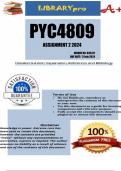PYC4809
ASSIGNMENT 2 2024
UNIQUE NO. 635137
DUE DATE: 17 July 2024
, PYC4809
Assignment 2 2024
UNIQUE NO.635137
DUE DATE: 17 July 2024
Therapeutic Psychology
UNISA@2024
, Section A
1. Briefly Describe a Therapeutic Approach: Cognitive Behavioral Therapy (CBT)
Cognitive Behavioral Therapy (CBT) is a widely-used, evidence-based
psychotherapeutic approach that aims to address dysfunctional emotions, behaviors,
and cognitive processes through a goal-oriented, systematic procedure. Developed by
Aaron Beck in the 1960s, CBT is grounded in the concept that our thoughts, feelings,
and behaviors are interconnected, and that altering negative thought patterns can lead
to changes in emotions and behaviors.
Core Principles of CBT
1. Cognitive Restructuring: This involves identifying and challenging distorted or
maladaptive thinking patterns (cognitive distortions) and replacing them with
more realistic and balanced thoughts. Common cognitive distortions include all-
or-nothing thinking, overgeneralization, and catastrophizing.
2. Behavioral Interventions: These are strategies to modify behavior, such as
exposure therapy for anxiety disorders, activity scheduling for depression, and
skills training for interpersonal effectiveness. Behavioral interventions help clients
test and change their behaviors in real-life situations.
3. Psychoeducation: Educating clients about their psychological issues and the
CBT process empowers them to take an active role in their therapy.
Understanding the link between thoughts, emotions, and behaviors helps clients
recognize and alter dysfunctional patterns.
4. Skill Development: CBT equips clients with practical skills to manage their
symptoms, such as problem-solving, stress management, and coping strategies.
These skills are practiced both within sessions and as homework assignments to
reinforce learning and promote self-efficacy.
5. Therapeutic Relationship: Although CBT is structured and directive, the
therapeutic relationship is collaborative. Therapists work with clients to set goals,




